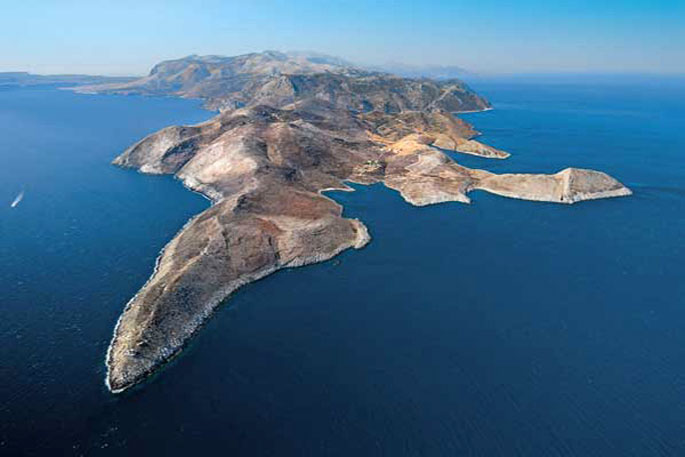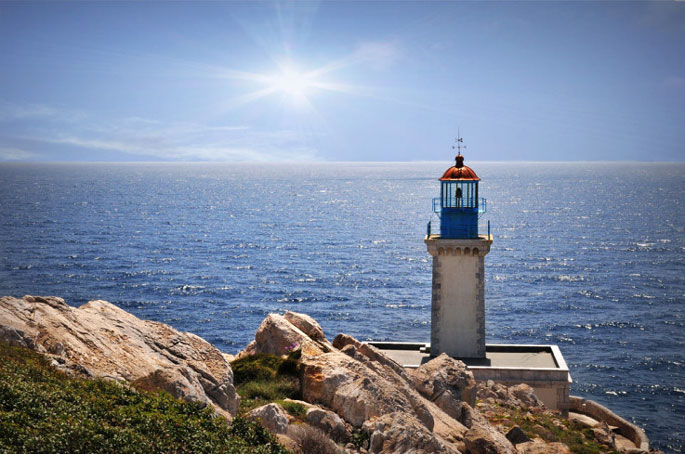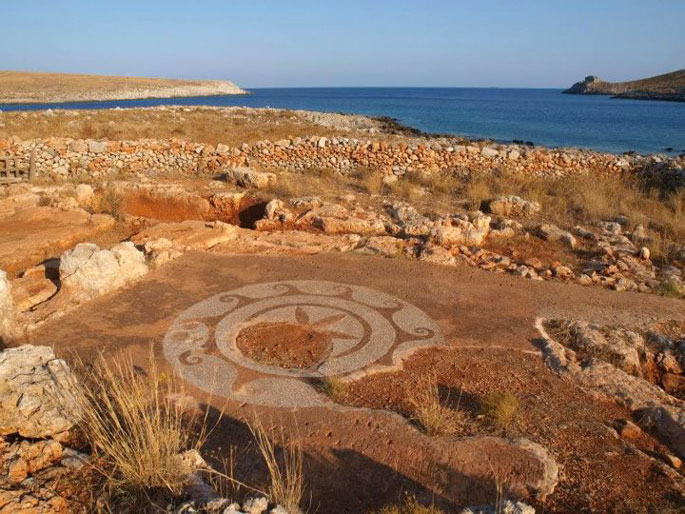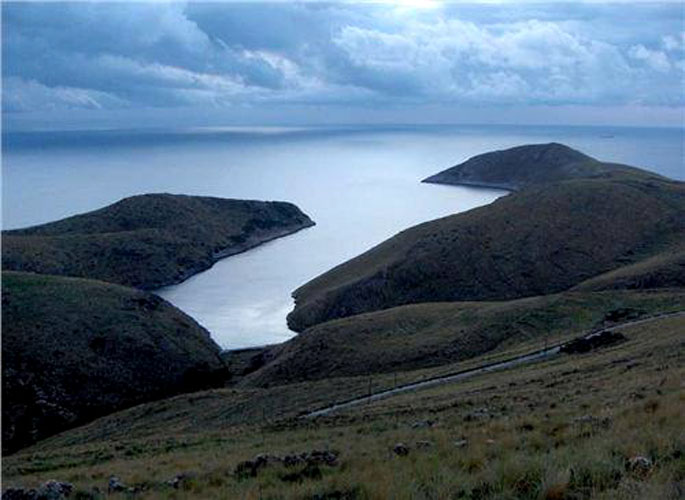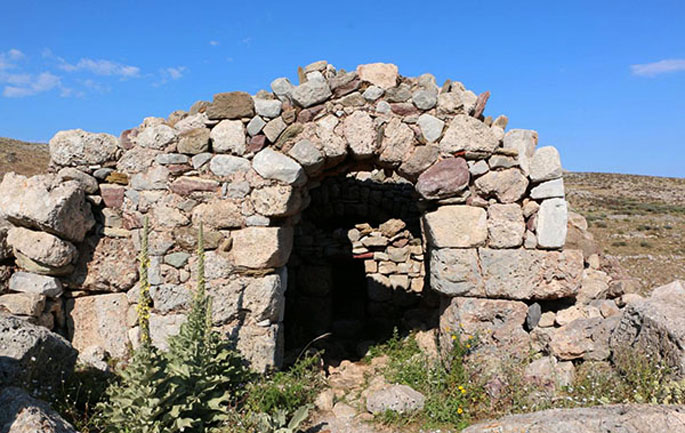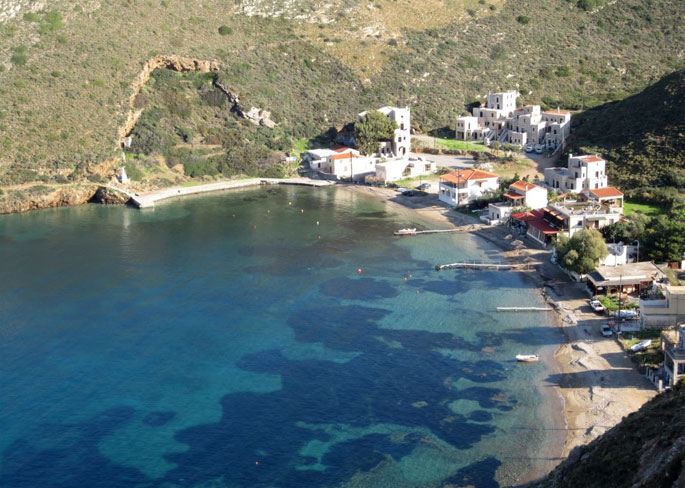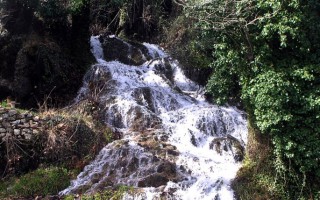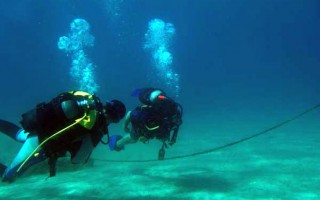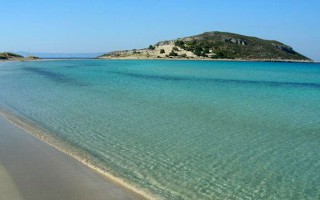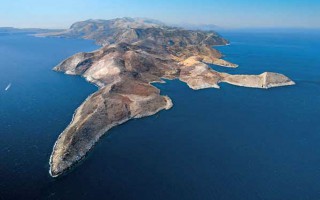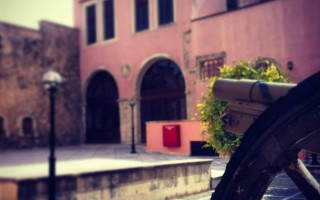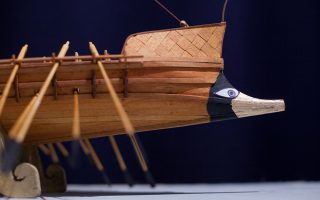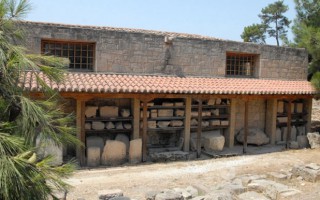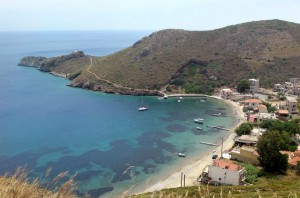 The ancient people believed that at the end of Mani and of the mainland of Europe were the gates to the Underworld. The visitors can reach on foot the Cape Tenaro, which is filled with remains of antiquities, from the path starting from the little church of Agioi Asomatoi which was built using the stones from the Sanctuary of Poseidon Tenarios. If you walk east, you’ll find sculpted on the rock the Psychomanteion (oracle of the dead) from where the Psychopompos (the guider of souls, the ferryman) collected the souls and accompanied them to the gate of Hades, a sea cave were Hercules passed in order to confront Kerveros, the beast that guarded the Underworld. If you walk west, you can find traces of the ancient and roman settlement like the great mural of the 1st century A.D. After a 45 minutes route, you’ll finally arrive to the lighthouse of Cape Tenaro, built in 1822, that signals the end of Mani and the Cape. At the beginning of the Cape, Marmari and Porto Kayio are ideal for swimming in their crystal clear beaches. Don’t forget to visit the settlements Paliro and Vatheia, Achilleion and Grigorakis Tower at the village Charakes. It’s worth it!
The ancient people believed that at the end of Mani and of the mainland of Europe were the gates to the Underworld. The visitors can reach on foot the Cape Tenaro, which is filled with remains of antiquities, from the path starting from the little church of Agioi Asomatoi which was built using the stones from the Sanctuary of Poseidon Tenarios. If you walk east, you’ll find sculpted on the rock the Psychomanteion (oracle of the dead) from where the Psychopompos (the guider of souls, the ferryman) collected the souls and accompanied them to the gate of Hades, a sea cave were Hercules passed in order to confront Kerveros, the beast that guarded the Underworld. If you walk west, you can find traces of the ancient and roman settlement like the great mural of the 1st century A.D. After a 45 minutes route, you’ll finally arrive to the lighthouse of Cape Tenaro, built in 1822, that signals the end of Mani and the Cape. At the beginning of the Cape, Marmari and Porto Kayio are ideal for swimming in their crystal clear beaches. Don’t forget to visit the settlements Paliro and Vatheia, Achilleion and Grigorakis Tower at the village Charakes. It’s worth it!
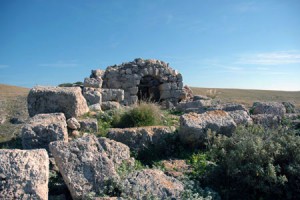 Where Mani and the mainland Greece end, there at the most southern edge of Europe and Balkan Peninsula you can find Cape Tenaro. The ancient Greeks believed that this place was the gate to the Underworld. It was named after the mythical hero and settler Tenaros, son of Zeus, who built this town at the isthmus of the Mani’s most southern peninsula, Akrotenaro. This Cape in the ancient times was also called “Poseidion” while later during the Frankish Occupation it was renamed into Cape Matapias, name which still exists in many nautical maps. According to mythology, here was supposed to be located the gate of Hades, a sea cave where Hercules passed in order to confront Kerveros, the beast that guarded the Underworld. The same gate crossed Orpheus to go and find Evridiki and in there hid the Spartan Arpalos who stole Alexander the Great’s treasures. In the modern history, the sea area around Cape Tenaro reminds us of the naval battle of Tenaro in 1942. This place has a special charm since it is filled with scattered remains and it has the characteristic beauty and energy of the Maniatic landscape.
Where Mani and the mainland Greece end, there at the most southern edge of Europe and Balkan Peninsula you can find Cape Tenaro. The ancient Greeks believed that this place was the gate to the Underworld. It was named after the mythical hero and settler Tenaros, son of Zeus, who built this town at the isthmus of the Mani’s most southern peninsula, Akrotenaro. This Cape in the ancient times was also called “Poseidion” while later during the Frankish Occupation it was renamed into Cape Matapias, name which still exists in many nautical maps. According to mythology, here was supposed to be located the gate of Hades, a sea cave where Hercules passed in order to confront Kerveros, the beast that guarded the Underworld. The same gate crossed Orpheus to go and find Evridiki and in there hid the Spartan Arpalos who stole Alexander the Great’s treasures. In the modern history, the sea area around Cape Tenaro reminds us of the naval battle of Tenaro in 1942. This place has a special charm since it is filled with scattered remains and it has the characteristic beauty and energy of the Maniatic landscape.
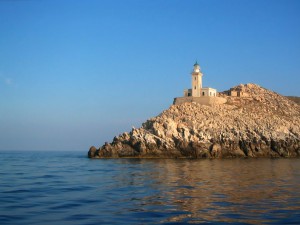 First, the Cape forms a narrow strip of land that is compressed by two bays from the eastern and western side. On the western side we can see the bay Porto Marinari with the homonymous settlement and on the eastern side Porto Kayio. Later the Cape becomes wider. The road stops after the settlement Kokkinogeia, at the church of Agioi Asomatoi where the Sanctuary of Poseidon Tenarios is situated, god of the Underworld for the ancient people of Lacedaimonia. If you walk east, you can find next to a small beach the Psychomanteion (oracle of the dead) from where the Psychopompos (the guider of souls, the ferryman) collected the souls and accompanied them to the gate of Hades, a sea cave whose exact place has not been determined yet. In the cave the existence of a Poseidon’s necromanteion is also reported. If you go west of the church, after a 45 minutes route, you’ll finally arrive to the lighthouse of Cape Tenaro, a rectangle stone building, 16 m tall, built in 1822 and 20 meters above sea level. The French constructed it and it started operating in 1887. Until 1984 it had three lighthouse keepers and since then its guarding and operation were conducted by an automatic lighting mechanism based on the solar energy. If you keep going, you’ll find traces of the ancient Greek and Roman settlement with the impressive “Aria’s Star”, an ancient decorative mosaic of the 1st century A.D. If you go even further, on the northern side of the lighthouse you’ll pass the Mani near the prefecture of Messinia.
First, the Cape forms a narrow strip of land that is compressed by two bays from the eastern and western side. On the western side we can see the bay Porto Marinari with the homonymous settlement and on the eastern side Porto Kayio. Later the Cape becomes wider. The road stops after the settlement Kokkinogeia, at the church of Agioi Asomatoi where the Sanctuary of Poseidon Tenarios is situated, god of the Underworld for the ancient people of Lacedaimonia. If you walk east, you can find next to a small beach the Psychomanteion (oracle of the dead) from where the Psychopompos (the guider of souls, the ferryman) collected the souls and accompanied them to the gate of Hades, a sea cave whose exact place has not been determined yet. In the cave the existence of a Poseidon’s necromanteion is also reported. If you go west of the church, after a 45 minutes route, you’ll finally arrive to the lighthouse of Cape Tenaro, a rectangle stone building, 16 m tall, built in 1822 and 20 meters above sea level. The French constructed it and it started operating in 1887. Until 1984 it had three lighthouse keepers and since then its guarding and operation were conducted by an automatic lighting mechanism based on the solar energy. If you keep going, you’ll find traces of the ancient Greek and Roman settlement with the impressive “Aria’s Star”, an ancient decorative mosaic of the 1st century A.D. If you go even further, on the northern side of the lighthouse you’ll pass the Mani near the prefecture of Messinia.
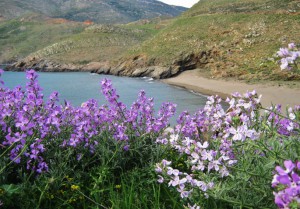 The three sandy beaches of Marmari and the beach of Porto Kayio are suitable for swimming. Moreover, you should definitely pay a visit to the small settlement of Achilleio with its tower houses over Porto Kayio, the imposing Grigorakakis Tower at a location named Charakes and the traditional settlements of Paliro and Vatheia.
The three sandy beaches of Marmari and the beach of Porto Kayio are suitable for swimming. Moreover, you should definitely pay a visit to the small settlement of Achilleio with its tower houses over Porto Kayio, the imposing Grigorakakis Tower at a location named Charakes and the traditional settlements of Paliro and Vatheia.
Source: www.mythicalpeloponnese.gr

